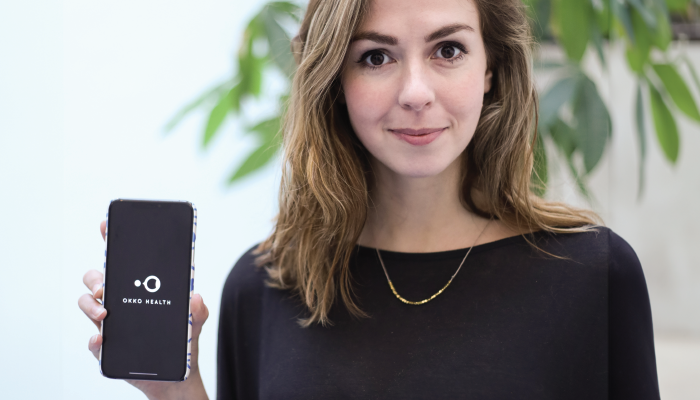
Stephanie Campbell
OKKO Health, a UK-based company focused on developing innovative eye health technology, has teamed up with the University of Plymouth to stress test its technology – a remote vision monitoring app – in extreme environments, such as the depths of a cave and outer space. We met up with CEO Stephanie Campbell, and Daniele Oehring, optometrist and vision scientist at the University of Plymouth, to discuss the collaboration, and how exactly the app aims to improve the future of remote vision monitoring.
What technology is used in your vision monitoring app?
Stephanie Campbell: Essentially, we’re harnessing the capability of a smartphone to become a kind of vision science pool. Our core technology puts optotypes on the screen, a bit like a letter chart but in video game format; it’s a very simple puzzle game made up of circles of different sizes and difficulties. So we’re merging gaming technology with vision science and data science.
The primary information that comes out of the app is measured in logMAR. Ophthalmologists prescribe the app and patients with macular degeneration use it three times a week to monitor their vision. From the data that’s collected, we can tell if the patient’s vision deteriorates, providing a “safety net” between their appointments.
The app also has a distortion tool, a bit like a modern version of an Amsler grid. This measures a patient’s threshold and the lowest line they can read, but also captures things like whether a patient struggled to get a line, their reaction time, and the number of mistakes they made. Gathering this type of information gives a much earlier indication of whether a patient’s vision is beginning to change.
Daniela Oehring: The app was instrumental in our project, “Feasibility of Human Physiological and Cognitive Responses in Extreme Analogue Environments: Multidisciplinary Investigations into Vision, Cognition, Masticatory Functions and Environmental Empathy.” It facilitated remote visual health monitoring by employing smartphone sensors to measure visual indicators beyond basic visual acuity. The app cleverly integrates vision science with clinical insights and gaming technology to engage participants through a simple video game format. While participants play these games, the app precisely captures data on their vision. This feature is invaluable in the extreme conditions simulated by the cave environment, where traditional vision assessment tools are impractical. The app’s ability to operate without additional hardware makes it uniquely suited for use in isolated and extreme settings, providing continuous and reliable vision health monitoring essential for the project's success.
Can you tell us about the collaboration with the University of Plymouth?
SC: Daniela wanted to get accurate measurements in space, because astronauts’ vision can be impacted by space travel in microgravity. As part of this project, astronauts spent a week in a cave with sensory deprivation; their vision was monitored every day using the app.
DO: These studies are conducted in the unique setting of the Natal Cave, using its isolated and controlled environment to mirror the challenges faced during prolonged space missions. The project aimed to discern how different aspects of human physiology and psychology respond to the environmental stressors of isolation, confinement, and unusual living conditions. This understanding is pivotal in designing better life support and monitoring systems for long-duration space travel and other isolated environments.
The app was integral to the project’s methodology by allowing the continuous, remote monitoring of crucial visual health indicators under extreme conditions. The application of the app in this research setting exemplifies an innovative approach to eye care, blending modern technology with rigorous scientific research to enhance our understanding of human health under duress. This project pushed the boundaries of where and how eye care can be administered, and set a precedent for future exploratory missions in how health monitoring can be seamlessly integrated into daily activities.
What fueled the app’s development, and how do you think it might contribute to the future of eye care?
SC: I believe that vision measurements should not be restricted to professionals – the way forward is to put data in the hands of the patient. Patients can be trusted to monitor their vision between appointments, and our healthcare system is becoming more receptive now to home monitoring. We’re seeing it in diabetes, for example, and in fertility care. I’m excited that patients who live with chronic eye disease can finally have the chance to self-monitor.
Smartphone technology will also allow for earlier identification of diseases. UK patients who have dry macular degeneration are monitored by their optometrist and also monitored at home using this technology, so if their condition changes to wet macular degeneration, they can be fast-tracked.
DO: The integration of mobile health technology in eye care research – as demonstrated by using the OKKO app in this project – can transform future approaches by allowing for continuous, real-time monitoring of vision and ocular health in extreme conditions. This could lead to personalized eye care strategy advancements, particularly in adapting to challenging environments such as space missions or other isolated settings.
SC: One of the key things I learned during our research is the importance of patient engagement. The great thing about having apps that measure vision is that you can educate the patient at home. So we also have an education module on the app, which explains to patients what their disease is, what support is available, and why they need to keep going to their appointments. We believe that this will help drive adherence to therapies.
